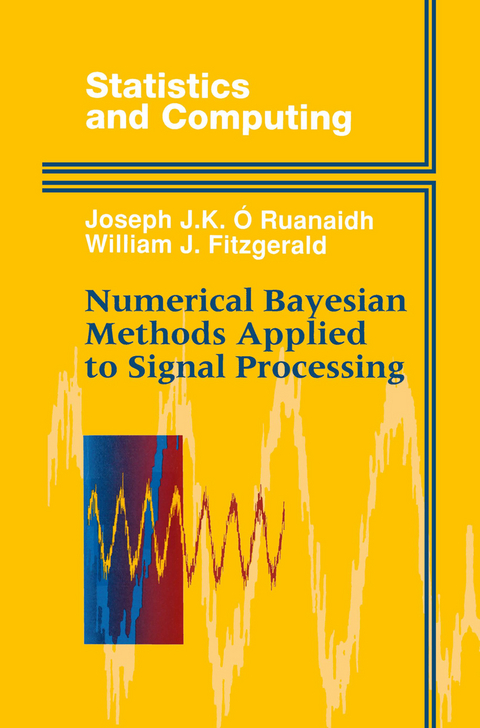
Numerical Bayesian Methods Applied to Signal Processing
Springer-Verlag New York Inc.
978-0-387-94629-0 (ISBN)
1 Introduction.- 2 Probabilistic Inference in Signal Processing.- 2.1 Introduction.- 2.2 The likelihood function.- 2.3 Bayesian data analysis.- 2.4 Prior probabilities.- 2.5 The removal of nuisance parameters.- 2.6 Model selection using Bayesian evidence.- 2.7 The general linear model.- 2.8 Interpretations of the general linear model.- 2.9 Example of marginalization.- 2.10 Example of model selection.- 2.11 Concluding remarks.- 3 Numerical Bayesian Inference.- 3.1 The normal approximation.- 3.2 Optimization.- 3.3 Integration.- 3.4 Numerical quadrature.- 3.5 Asymptotic approximations.- 3.6 The Monte Carlo method.- 3.7 The generation of random variates.- 3.8 Evidence using importance sampling.- 3.9 Marginal densities.- 3.10 Opportunities for variance reduction.- 3.11 Summary.- 4 Markov Chain Monte Carlo Methods.- 4.1 Introduction.- 4.2 Background on Markov chains.- 4.3 The canonical distribution.- 4.4 The Gibbs sampler.- 4.5 The Metropolis-Hastings algorithm.- 4.6 Dynamical sampling methods.- 4.7 Implementation of simulated annealing.- 4.8 Other issues.- 4.9 Free energy estimation.- 4.10 Summary.- 5 Retrospective Changepoint Detection.- 5.1 Introduction.- 5.2 The simple Bayesian step detector.- 5.3 The detection of changepoints using the general linear model.- 5.4 Recursive Bayesian estimation.- 5.5 Detection of multiple changepoints.- 5.6 Implementation details.- 5.7 Multiple changepoint results.- 5.8 Concluding Remarks.- 6 Restoration of Missing Samples in Digital Audio Signals.- 6.1 Introduction.- 6.2 Model formulation.- 6.3 The EM algorithm.- 6.4 Gibbs sampling.- 6.5 Implementation issues.- 6.6 Relationship between the three restoration methods.- 6.7 Simulations.- 6.8 Discussion.- 6.9 Concluding remarks.- 7 Integration in Bayesian Data Analysis.- 7.1 Polynomial data.-7.2 Decay problem.- 7.3 General model selection.- 7.4 Summary.- 8 Conclusion.- 8.1 A review of the work.- 8.2 Further work.- A The General Linear Model.- A.1 Integrating out model amplitudes.- A.1.1 Least squares.- A.1.2 Orthogonalization.- A.2 Integrating out the standard deviation.- A.3 Marginal density for a linear coefficient.- A.4 Marginal density for standard deviation.- A.5 Conditional density for a linear coefficient.- A.6 Conditional density for standard deviation.- B Sampling from a Multivariate Gaussian Density.- C Hybrid Monte Carlo Derivations.- C.1 Full Gaussian likelihood.- C.2 Student-t distribution.- C.3 Remark.- D EM Algorithm Derivations.- D.l Expectation.- D.2 Maximization.- E Issues in Sampling Based Approaches to Integration.- E.1 Marginalizing using the conditional density.- E.2 Approximating the conditional density.- E.3 Gibbs sampling from the joint density.- E.4 Reverse importance sampling.- F Detailed Balance.- F.1 Detailed balance in the Gibbs sampler.- F.2 Detailed balance in the Metropolis Hastings algorithm..- F.3 Detailed balance in the Hybrid Monte Carlo algorithm..- F.4 Remarks.- References.
| Reihe/Serie | Statistics and Computing |
|---|---|
| Zusatzinfo | XIV, 244 p. |
| Verlagsort | New York, NY |
| Sprache | englisch |
| Maße | 155 x 235 mm |
| Themenwelt | Informatik ► Grafik / Design ► Digitale Bildverarbeitung |
| Mathematik / Informatik ► Informatik ► Theorie / Studium | |
| Mathematik / Informatik ► Mathematik ► Wahrscheinlichkeit / Kombinatorik | |
| ISBN-10 | 0-387-94629-2 / 0387946292 |
| ISBN-13 | 978-0-387-94629-0 / 9780387946290 |
| Zustand | Neuware |
| Haben Sie eine Frage zum Produkt? |
aus dem Bereich


